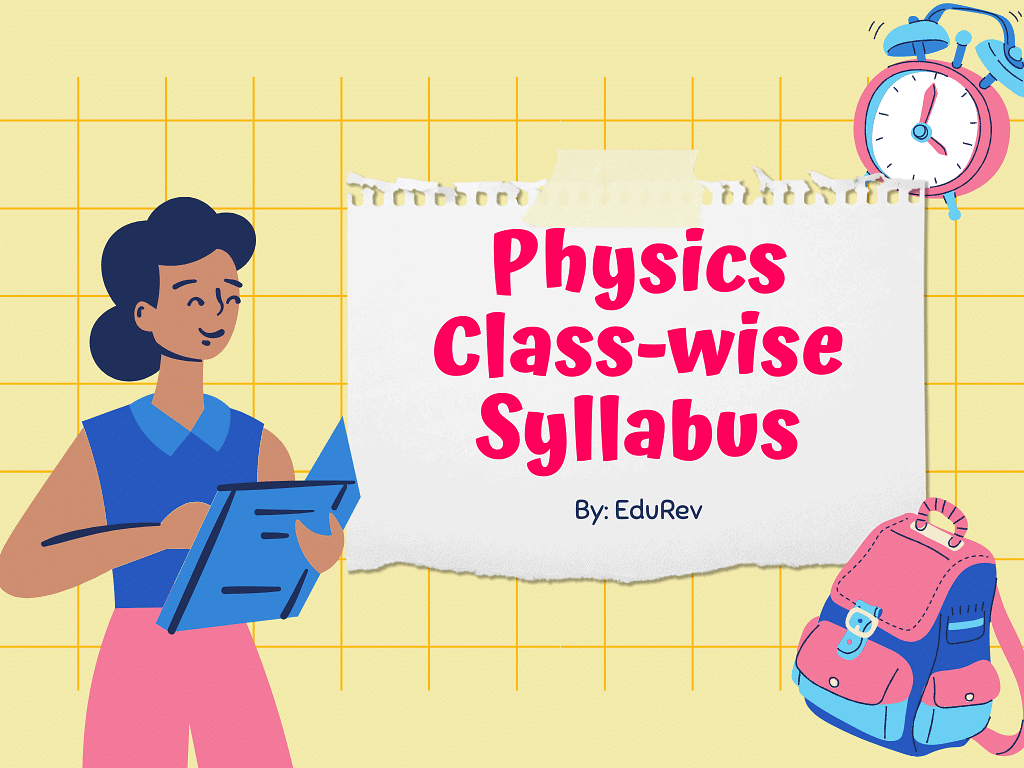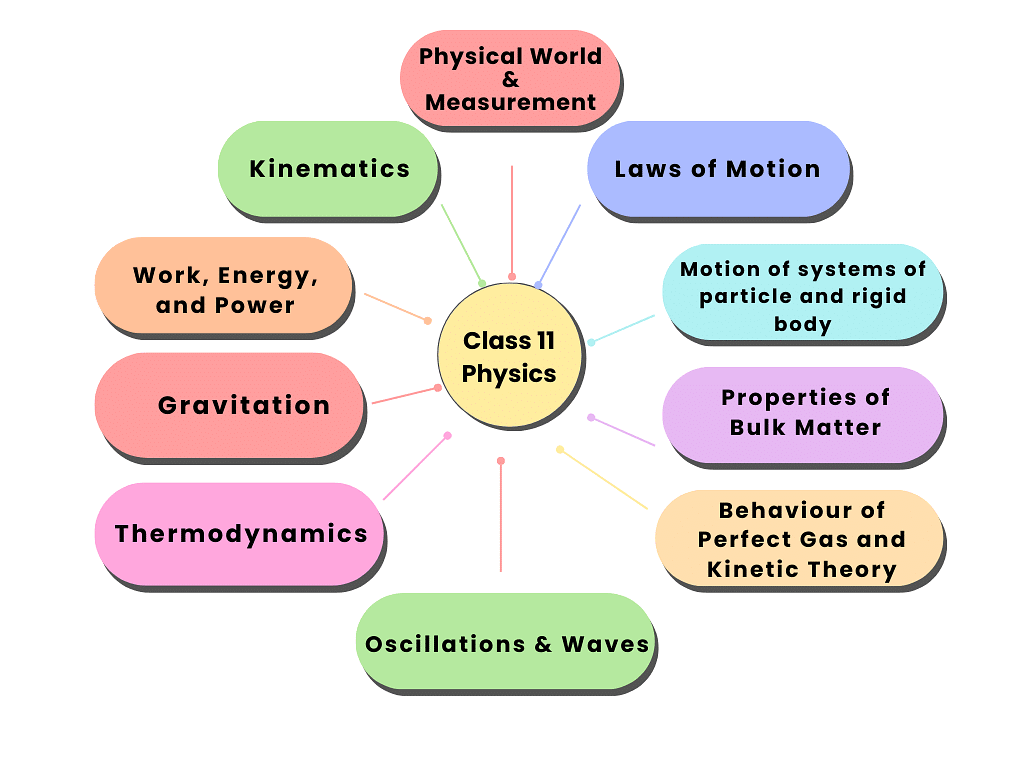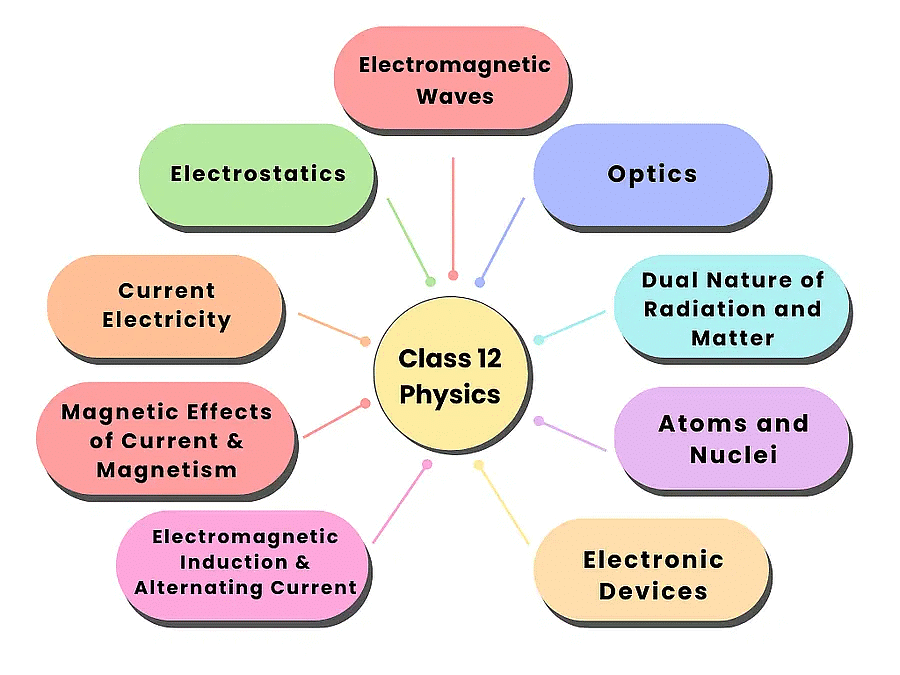NEET Physics Syllabus & Weightage 2023 | News & Notifications: NEET PDF Download
Understanding the curriculum of each subject in advance can assist students in their preparation for the NEET assessment. Physics is a significant subject for NEET, so aspirants should carefully get the NEET Physics syllabus to get ready for the NEET 2024 exam and secure good grades.
All the aspirants must look over the syllabus to know which chapters carry more marks from the NEET 2024 Physics syllabus in the NEET 2024 exam. When you have done studying the syllabus, take NEET mock tests or solve the NEET previous year's question papers to evaluate your knowledge.

Class-wise NEET Physics Syllabus
In this EduRev document, we will see the Physics class-wise syllabus in detail. The table below outlines the different chapters of Physics Class 11 and Physics Class 12, along with the chapters that each unit covers.
Class 11th Physics Syllabus | Class 12th Physics Syllabus |
Units and measurement | Electrostatics |
Kinematics | |
Magnetic Effects of Current and Magnetism | |
Electromagnetic Induction and Alternating Currents | |
Motion of System of Particles and Rigid Body | |
Optics | |
Properties of Bulk Matter | |
Atoms and Nuclei | |
Behavior of Perfect Gas and Kinetic Theory | Electronic Devices |
Oscillations and wave |
Class 11 NEET Physics Chapter-wise Syllabus
The syllabus of Physics outlines all the topics of each chapter that are relevant for exams, allowing students to focus on the most important topics while studying each and every chapter.

Unit 1 – Units and Measurement
- Physics: Units of measurement. System of Units, S I Units, fundamental and derived units, least count. significant figures, Errors in measurements, and Dimensions of Physics quantities. dimensional analysis, and its applications
Unit 2 – Kinematics
- Frame of reference, motion in a straight line; position-time graph, speed, and velocity. Uniform and non-uniform motion, average speed, and instantaneous velocity. Uniformly accelerated motion, velocity-time, and position-time graphs for uniformly accelerated motion (graphical treatment)
- Elementary concepts of differentiation and integration for describing motion. Scalar and vector quantities: Position and displacement vectors, general vectors, general vectors and notation, equality of vectors, multiplication of vectors by a real number; addition and subtraction of vectors. Relative velocity
- Unit vectors. Resolution of a vector in a plane-rectangular components
- Scalar and vector products of vectors. Motion in a plane. Cases of uniform velocity and uniform acceleration – projectile motion. Uniform circular motion.
Unit 3 – Laws of Motion
- Intuitive concept of force. Inertia, Newton’s first law of motion; momentum and Newton’s second law of motion; impulse; Newton’s third law of motion. Law of conservation of linear momentum and its applications
- Equilibrium of concurrent forces. Static and kinetic friction, laws of friction, rolling friction, lubrication
- Dynamics of uniform circular motion. Centripetal force, examples of circular motion (vehicle on level circular road, vehicle on banked road)
Unit 4 – Work, Energy, and Power
- Work done by a constant force and variable force; kinetic energy, work-energy theorem, power.
- Notion of potential energy, potential energy of a spring, conservative forces; conservation of mechanical energy (kinetic and potential energies); non-conservative forces; motion in a vertical circle, elastic and inelastic collisions in one and two dimensions.
Unit 5 – Motion of systems of particle and rigid body
- Centre of mass of a two-particle system, momentum conservation and centre of mass motion. Centre of mass of a rigid; Centre of mass of uniform rod
- The momentum of a force-torque, angular momentum, conservation of angular momentum with some examples
- Equilibrium of rigid bodies, rigid body rotation and equation of rotational motion, comparision of linear and rotational motions; moment of inertia, radius of gyration. Values of M.I. for simple geometrical objects (no derivation). Statement of parallel and perpendicular axes theorems and their applications.
Unit 6 – Gravitation
- Kepler’s law of planetary motion. The universal law of gravitation. Acceleration due to gravity and its variation with altitude and depth
- Gravitational potential energy; gravitational potential. Escape velocity, the orbital velocity of a satellite. Geostationary satellites
Unit 7 – Properties of Bulk Matter
- Elastic behavior, stress-strain relationship. Hooke’s law, Young’s modulus, bulk modulus, shear, modulus of rigidity, Poisson's ratio; elastic energy
- Viscosity, Stoke’s law, terminal velocity, Reynold’s number, streamline, and turbulent flow. Critical velocity, Bernoulli’s theorem, and its applications.
- Surface energy and surface tension, angle of contact, excess of pressure, application of surface tension ideas to drops, bubbles, and capillary rise
- Heat, temperature, thermal expansion; thermal expansion of solids, liquids, and gases. Anomalous expansion. Specific heat of capacity: Cp, Cv-calorimetry; change of state-latent heat
- Heat transfer – conduction and thermal conductivity, convection, and radiation. Qualitative ideas of Black body radiation. Wein’s displacement law, and the greenhouse effect.
Newton’s law of cooling and Stefan’s law
Unit 8 – Thermodynamics
- Thermal equilibrium and definition of temperature (zeroth law of thermodynamics).
- Heat, work, and internal energy.
- The first law of thermodynamics: Isothermal and adiabatic processes.
- The second law of thermodynamics: Reversible and irreversible processes. Heat engines and refrigerators.
Unit 9 – Behaviour of Perfect Gas and Kinetic Theory
- Equation of state of a perfect gas, work done on compressing a gas
- Kinetic theory of gases: Assumptions, concept of pressure. Kinetic energy and temperature; degrees of freedom, law of equipartition of energy (Statement only) and application to specific heat capacities of gases; concept of mean free path.
Unit 10– Oscillations & Waves
- Periodic motion-period, frequency, displacement as a function of time. Periodic functions. Simple harmonic motion(SHM) and its equation; phase; oscillations of a spring-restoring force and force constant; energy in SHM – Kinetic and potential energies; simple pendulum – derivation of expression for its time period; free and forced and damped oscillations (qualitative ideas only), resonance
- Wave motion. Longitudinal and transverse waves, speed of wave motion. Displacement relation for a progressive wave. Principle of superposition of waves, reflection of waves, standing waves in strings and organ pipes, fundamental mode and harmonics. Beats. Doppler effect.
Class 12 NEET Physics Chapter-wise Syllabus
The syllabus of Physics outlines all the topics of each chapter that are relevant for exams, allowing students to focus on the most important topics while studying each and every chapter.

Unit 1 – Electrostatics
- Electric charges and their conservation. Coulomb’s law-force between two point charges, forces between multiple charges; superposition principle, and continuous charge distribution
- Electric field, electric field due to a point charge, electric field lines; electric dipole, electric field due to a dipole; torque on a dipole in a uniform electric field
- Electric flux, statement of Gauss’s theorem and its applications to find field due to infinitely long straight wire, uniformly charged infinite plane sheet, and uniformly charged thin spherical shell (field inside and outside)
- Electric potential, potential difference, electric potential due to a point charge, a dipole, and system of charges: equipotential surfaces, electrical potential energy of a system of two point charges and of electric dipoles in an electrostatic field.
- Conductors and insulators, free charges, and bound charges inside a conductor. Dielectrics and electric polarization, capacitors, and capacitance, a combination of capacitors in series and in parallel, capacitance of a parallel plate capacitor with and without dielectric medium between the plates, energy stored in a capacitor, Van de Graaff generator.
Unit 2 – Current Electricity
- Electric current, the flow of electric charges in a metallic conductor, drift velocity and mobility, and their relation with electric current; Ohm’s law, electrical resistance, V-I characteristics (linear and non-linear), electrical energy and power, electrical resistivity and conductivity
- Carbon resistors, colour code for carbon resistors; series and parallel combinations of resistors; temperature dependence of resistance.
- Internal resistance of a cell, potential difference and emf of a cell, combination of cells in series and in parallel
- Kirchoff’s laws and simple applications. Wheatstone bridge, metre bridge
- Potentiometer-principle and applications to measure potential difference and for comparing emf of two cells; measurement of internal resistance of a cell.
Unit 3 – Magnetic Effects of Current & Magnetism
- Concept of magnetic field, Oersted’s experiment. Biot-Savart law and its application to current carrying circular loop
- Ampere’s law and its applications to infinitely long straight wire, straight and toroidal solenoids. Force on a moving charge in uniform magnetic and electric fields. Cyclotron
- Force on a current-carrying conductor in a uniform magnetic field. Force between two parallel current-carrying conductors – definition of ampere. Torque experienced by a current loop in a magnetic field; moving coil galvanometer – its current sensitivity and conversion to ammeter and voltmeter
- Current loop as a magnetic dipole and its magnetic dipole moment. Magnetic dipole moment of a revolving electron. Magnetic Field Intensity due to a magnetic dipole(bar magnet) along its axis and perpendicular to its axis. Torque on a magnetic dipole (bar magnet) in a uniform magnetic field; bar magnet as an equivalent soilenoid, magnetic field lines; Earth’s magnetic field; bar magnet as an equivalent solenoid, magnetic field lines; Earth’s magnetic field and magnetic elements.
- Para -, dia-and ferro-magnetic substances, with examples. Electromagnetic and factors affecting their strengths. Permanent magnets.
Unit 4 – Electromagnetic Induction and Alternating Current
- Electromagnetic induction; Faraday’s law, induced emf and current; Lenz’s law, eddy currents. Self and mutual inductance
- Alternating currents, peak and rms value of alternating current/voltage; reactance and impedance; LC oscillations (qualitative treatment only), LCR series circuit, resonance; power in AC circuits, wattles current
- AC generator and transformer.
Unit 5 – Electromagnetic Waves
- Need for displacement current
- Electromagnetic waves and their characteristics (qualitative ideas only). Transverse nature of electromagnetic waves
- Electromagnetic spectrum (radio waves, microwaves, infrared, visible, ultraviolet, x-rays, gamma rays) includes elementary facts about their uses.
Unit 6 – Optics
- Reflection of light, spherical mirrors, mirror formula. Refraction of light, total internal reflection and its applications optical fibers, refraction at spherical surfaces, lenses, thin lens formula, lens-maker’s formula. Magnification, power of a lens, combination of thin lenses in contact combination of a lens and a mirror. Refraction and dispersion of light through a prism
- Scattering of light–blue color of the sky and reddish appearance of the sun at sunrise and sunset
- Optical instruments: Human eye, image formation and accommodation, correction of eye defects (myopia and hyper myopia) using lenses
- Microscopes and astronomical telescopes (reflecting and refracting) and their magnifying powers.
- Wave optics: Wavefront and Huygen’s principle, reflection and refraction of plane wave at a plane surface using wavefronts
- Proof of laws of reflection and refraction using Huygen’s principle
Interference, Young’s double hole experiment and expression for fringe width, coherent sources and sustained interference of light. Diffraction due to a single slit, width of central maximum - Resolving power of microscopes and astronomical telescopes. Polarisation, plane polarized light; Brewster’s law, uses of plane-polarized light and polaroids.
Unit 7 – Dual Nature of Radiation and Matter
- Photoelectric effect, Hertz and Lenard’s observations; Einstein’s photoelectric equation – particle nature of light.
- Matter waves – wave nature of particles, deBrogile relation. Davisson-Germer experiment (experimental details should be omitted; only conclusion should be explained)
- Alpha – particle scattering experiments; Rutherford’s model fo atom; Bohr model, energy levels, hydrogen spectrum. Composition and size of nucleus, atomic masses, isotopes, isobars; isotones
- Radioactivity – alpha, beta and gamma particles/rays and their properties decay law. Mass-energy relation, mass defect; binding energy per nucleon and its variation with mass number, nuclear fission and fusion.
Unit 9 – Electronic Devices
- Energy bands in soilds (qualitative ideas only), conductors, insulators and semiconductors;
- semiconductor diode- I-V characteristics in forward and reverse bias,
- diode as a rectifier
- I-V characteristics of LED, photodiode, solar cell, and Zener diode
- Zener diode as a voltage regulator
- Junction transistor, transistor action, characteristics of a transistor
- transistor as an amplifier (common emitter configuration) and oscillator
- Logic gates (OR, AND, NOT, NAND and NOR).
Expected NEET 2022-23 Physics Chapter Wise Weightage
Name of Unit | Chapter’s name | Average no. of questions |
Units and Measurement | Units and Measurement | 1 |
Kinematics | - Motion in Straight Line - Motion in a Plane | 2 01-Feb |
Laws of Motion | Laws of Motion | 02-Mar |
Work, Energy and Power | Work, Energy and Power | 2 |
System of Particles and Rotational Motion | System of Particles and Rotational Motion | 02-Mar |
Gravitation | Gravitation | 2 |
Properties of Bulk Matter | - Mechanical Properties of Solids - Mechanical Properties of Fluids - Thermal Properties of Matter | 1 1 01-Feb |
Oscillations and Waves | - Oscillations - Waves | 01-Feb |
Thermodynamics | Thermodynamics | 01-Feb |
The behavior of Perfect Gas and Kinetic Theory | Kinetic Theory | 1 |
Electrostatics | - Electric Charges and Fields - Electrostatic Potential and Capacitance | 01-Feb |
Current Electricity | Current Electricity | 4 |
Magnetic Effects of Current and Magnetism | - Moving Charges and Magnetism - Magnetism and Matter | 2 1 |
Electromagnetic Induction and Alternating Currents | - Electromagnetic Induction - Alternating Currents | 1 1 |
Electromagnetic Waves | Electromagnetic Waves | 1 |
Optics | - Ray Optics and Optical Instrument - Wave Optics | 2 1 |
Dual Nature of Radiation and Matter | Dual Nature of Radiation and Matter | 02-Mar |
Atoms and Nuclei | - Atoms - Nuclei | 01-Feb 2 |
Electronic Devices | Semiconductor Electronics | 3 |
Communication Systems | Communication Systems | 01-Feb |
Frequently Asked Questions (FAQs) related to NEET Physics
Q. Is the NEET Physics syllabus tough?
NEET tests medical aspirants in Physics, Chemistry and Biology subjects for knowledge of NCERT syllabus for NEET majorly. Given the tough competition and the ever-increasing interest amongst students opting for medicine as a career, the question paper over the years has been deemed to be challenging. Having said that, all sections of NEET are equally challenging in their own ways, Physics section requires more attention and practice from students’ end as it requires them to apply learnt concepts and solve questions. So, answering the question, NEET Physics could be challenging if one does not have a strong grip on basic concepts.
Q. Can we skip some topics from the NEET Physics syllabus?
No, students must not leave any topic from the NEET Physics syllabus to score good marks. Instead, prepare all the topics according to the NEET syllabus for every subject.
Q. Is the NEET 2024 syllabus reduced?
The NEET syllabus for 2024 has not been reduced. However, there are some changes introduced in the NEET exam pattern as per NTA's latest notification. Firstly, the biology section of the syllabus has been divided into Botany and Zoology.
Q. Is NCERT enough for Physics NEET?
Physics is all about the numerical and based on concepts, therefore NCERT Physics books won't be enough for NEET preparations. Below are some of the books other than NCERT to crack NEET 2024.
Q. Will physics be removed from NEET 2024?
NEET 2023 Syllabus : As of now, there are no changes in the NEET 2023 syllabus and it will be the same as the previous year syllabus. If there would be any changes in the NEET syllabus, it will be updated on this page. The NEET syllabus covers chapters and topics from Class 11 and 12 Physics, Chemistry, and Biology.
Q. Can an average student crack NEET Physics?
Yes, an average student can certainly crack NEET 2024 exam with the highest scores, provided he/she is dedicated, invested in smart techniques and consistent with preparation strategy.
Q. How many chapters are there in total in NEET 2024 Physics syllabus?
In NEET Physics syllabus, there are a total of 29 chapters altogether in class 11 and 12 syllabi.





















